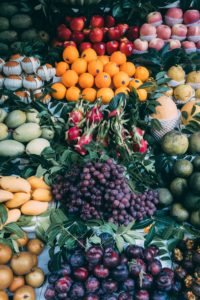 Superfoods have been all the rage for the last few decades. Although there is no standardized definition, this article out of UC Davis gives a great overview of how the term came to be–spoiler alert: it all started with bananas! In simple terms, superfoods give you the best bang for your buck with their abundance of micronutrients (vitamins, minerals, antioxidants, and other important molecules that impart benefits at minimal quantity) without an overabundance of calories. Think ancient grains, fruits, vegetables, and some fish.
Superfoods have been all the rage for the last few decades. Although there is no standardized definition, this article out of UC Davis gives a great overview of how the term came to be–spoiler alert: it all started with bananas! In simple terms, superfoods give you the best bang for your buck with their abundance of micronutrients (vitamins, minerals, antioxidants, and other important molecules that impart benefits at minimal quantity) without an overabundance of calories. Think ancient grains, fruits, vegetables, and some fish.
Since really digging into ingredients across all categories at the start of this year, I’ve noticed a plethora of fruit based ingredients, extracts and powders galore from widely recognized fruits as well as some that aren’t as well-known. Fruit powders and ingredients highly interest me from a product development perspective because they can be used to add color and flavor beyond their micronutrient power. Below is a small glimpse into a few ingredients I consider “superfruits” and am interested in for some current work projects:
- Blood Orange and Oranges: Oranges have always been known as a good source of vitamin C, yet only in recent years have scientists looked at the antioxidants within oranges and their potential health benefits. New studies show that orange extracts may be helpful with anxiety and weight loss. Orange components also show anticancer and cardioprotective activities.
- Golden Kiwi: To be honest, I had no idea gold kiwis were a thing until I had an ingredient supplier telling me about their golden kiwi powder. I’ve learned that golden kiwis look just like their green counterparts with some differences in micronutrient content (e.g. gold kiwi has greater vitamin C and folate content than green kiwi). Golden kiwi ingredients that I’ve seen thus far seem to primarily come from New Zealand, although kiwi can grow in several places around the globe. Ingredients from golden kiwi can support digestive health and studies on kiwi show it contributes to an increase in high-density lipoprotein (HDL, aka the good cholesterol).
- Pomegranate: Yes, I’ve mentioned pomegranates previously in my recent liver ingredients post–I’ve been fascinated with pomegranates ever since learning about them in my high school mythology class (thank you, Mrs. Swartz!). Pomegranate fits the superfruit mold because of all of the antioxidants it contains, like the anthocyanins that give pomegranate its red color. The active components in pomegranate exhibit anticancer and anti-inflammatory activities, making it potentially useful in the treatment of cancers and arthritis.
- Blueberries: Like pomegranates, blueberries also contain anthocyanins. In addition to the antioxidant potential of blueberries, recent research has shown they may be useful in slowing cognitive decline in older adults.
- Kakadu Plum: This fruit is another one whose existence I didn’t know until learning about it during a supplier meeting. Kakadu plums are better known in Australia, and like the other superfruits listed here, have high antioxidant activity and micronutrient content. Active components in Kakadu plums may be useful in inhibiting foodborne bacteria, thus potentially providing a natural alternative to some preservatives. I had trouble locating any clinical research on ingredients from this interesting plant but it seems to have a long history of use in aboriginal medicine.
As research continues on plants, especially those used in traditional medicine around the world, I’m sure this list will continue to grow. Are there specific fruits and fruit ingredients you find interesting for product development? Are there any fruits you swear by in your diet? I’d love to hear your thoughts, no matter how fruity.
